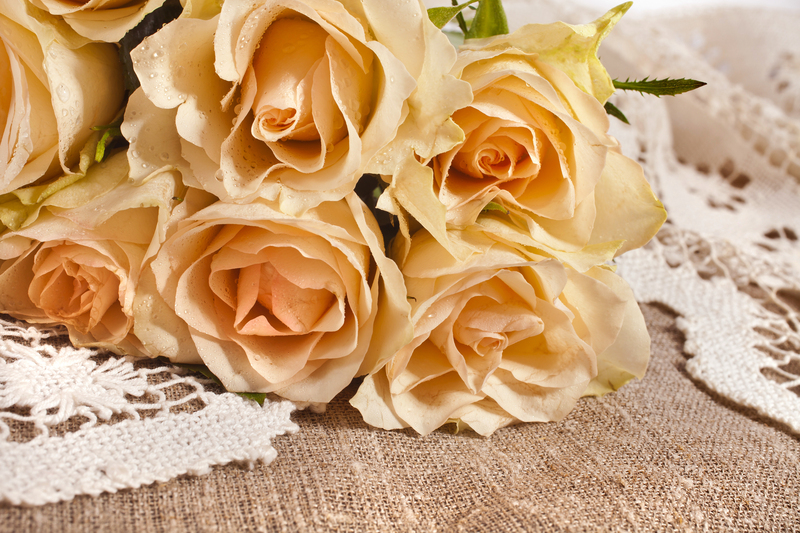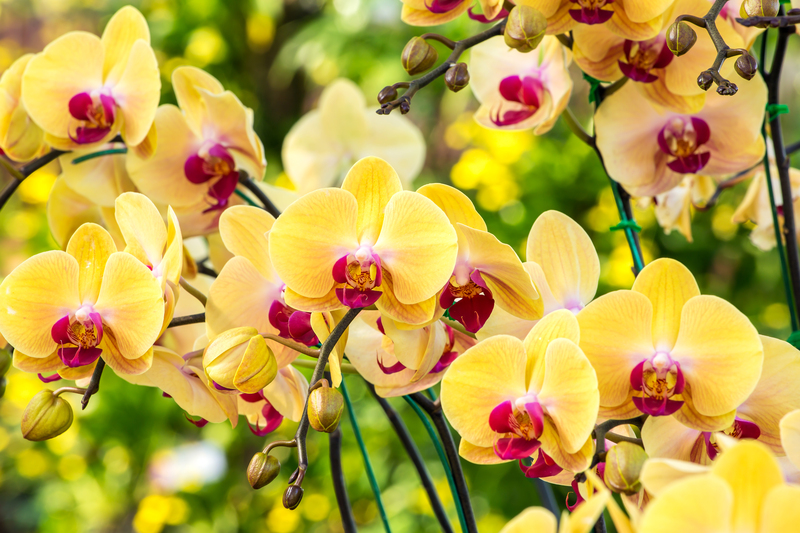Ensuring Orchid Longevity and Beauty
Posted on 10/06/2025
Ensuring Orchid Longevity and Beauty: Your Comprehensive Guide
Orchids are often hailed as the royalty of the plant world, celebrated for their exquisite beauty, alluring shapes, and vibrant colors. If you are an orchid enthusiast or a beginner seeking to ensure your orchids remain healthy, beautiful, and long-lasting, you've come to the right place. This expert guide provides a comprehensive exploration into the secrets of orchid longevity and ways to maintain their captivating beauty year-round.

Understanding Orchids: The Foundation of Longevity
The first step in ensuring orchid longevity and beauty is understanding their unique nature. With over 25,000 species and more than 100,000 hybrids, orchids adapt to a variety of environments, from tropical rainforests to arid savannahs. Knowing the specific requirements of your orchid will greatly aid in providing the best care possible.
Key Orchid Types for Homes and Gardens
- Phalaenopsis (Moth Orchid): Widely loved for their accessibility and extended blooms.
- Cattleya: Famous for large, fragrant flowers.
- Dendrobium: Known for diverse shapes and resilience.
- Oncidium (Dancing Lady): Delightful sprays of tiny blooms.
- Vanda: Stunning, vibrant blossoms, often cultivated by enthusiasts.
The Fundamentals of Orchid Longevity and Lasting Beauty
Orchid wellness hinges on several core elements. Addressing their light, water, temperature, humidity, and feeding requirements builds a strong foundation for lasting beauty and flowering vitality.
Optimal Light for Thriving Orchids
Light is a critical factor in both the longevity and visual appeal of your orchid. Most orchids thrive in bright, indirect light. Direct sunlight, especially in the afternoon, can scorch leaves. If natural light is insufficient, invest in artificial grow lights designed for orchids.
- Phalaenopsis and Paphiopedilum: Prefer east or north-facing windowsills.
- Cattleya and Vanda: Need more light; a south or west-facing position with sheer curtains is ideal.
- Tip: Leaf color signals light health--medium green is ideal for longevity.
Watering Orchids for Health and Longevity
Overwatering is the enemy of orchid longevity. Most orchids require watering only when their potting medium is nearly dry. A simple test: insert your finger an inch into the medium--if it's dry, it's time to water.
- Early morning watering prevents root rot and allows excess moisture to evaporate during the day.
- Use rainwater or distilled water when possible; tap water may contain salts harmful to orchids.
- Tip: Empty decorative pots and cache pots after watering to avoid standing water around roots.
Temperature and Humidity: Key to Vibrant Orchids
Orchids flourish in environments that mimic their native habitats. Stable temperatures and appropriate humidity levels are essential to preserving their longevity and natural beauty.
- Phalaenopsis: Prefer temperatures between 65-80?F (18-27?C)
- Cattleya and Oncidium: Thrive in slightly cooler temperatures at night.
- Humidity: Ideal is 40-70%. Use humidifiers, pebble trays, or group plants together to maintain desirable moisture levels.
Feeding Orchids: Fertility is Vital
For lasting orchid health and continuous blooms, regular feeding is crucial. Fertilize "weakly, weekly" using a balanced orchid fertilizer. Dilute feeds to half strength for best absorption and reduced risk of salt buildup.
- During growing season: Apply fertilizer every week. Reduce to once a month during dormancy.
- Flush pots with water monthly to prevent mineral buildup.
The Importance of Proper Potting
An often-overlooked aspect of orchid care is repotting. Orchids require well-draining media--often bark, sphagnum moss, or specialized soilless mixes.
- Repot every 1-2 years, preferably after blooming.
- Choose pots with ample drainage holes.
- Trim dead roots and replace old medium to prevent disease.
Promoting Orchid Longevity and Flowering
Encouraging Re-Blooming in Orchids
One of the greatest joys (and challenges) of orchid care is encouraging your orchid to bloom again. Understanding the flower cycle and mimicking environmental triggers can help.
- Temperature difference: Many orchids need a drop (about 10?F/5?C) in night temperatures to initiate spikes.
- Water properly during the growth phase but reduce slightly as the bloom spike appears.
- Provide ample light, but avoid leaf burn, especially during the spike stage.
- Do not cut green spikes: Phalaenopsis may re-bloom from existing spikes.
Pest and Disease Prevention for Lasting Beauty
If left unchecked, pests and diseases can compromise both the health and beauty of your orchids. Early detection and prompt treatment are critical.
- Inspect leaves and roots regularly for signs of spider mites, scale, aphids, or mealybugs.
- Fungal and bacterial infections often appear as leaf spots or mushy roots--ensure air circulation and avoid wetting foliage.
- Treat minor infestations with insecticidal soap or neem oil; quarantine affected plants to prevent spread.
Maintaining Orchid Beauty: Grooming and Display
Grooming for Healthy, Gorgeous Orchids
- Remove dead or yellowing leaves promptly with sterilized scissors.
- Clean dust from leaves gently with a damp cloth to maintain their luster and maximize photosynthesis.
- Stake flower spikes when needed to showcase blooms and prevent stem breakage.
Displaying Orchids for Maximum Impact
- Choose decorative containers that allow for airflow and drainage.
- Arrange orchids in groups for humidity and visual appeal.
- Rotate pots periodically to ensure even growth and sun exposure for all sides.
Common Mistakes That Shorten Orchid Lifespan
Even the most diligent orchid caretakers can fall victim to simple mistakes. Avoiding the following pitfalls can dramatically improve orchid longevity and flower quality:
- Overwatering: Root rot is the #1 killer of orchids.
- Insufficient light: Leads to poor growth and lack of blooms.
- Improper fertilization: Overfeeding causes salt buildup, while underfeeding starves the plant.
- Neglecting humidity: Orchids desiccate quickly in dry conditions.
- Delaying repotting: Old, decayed media harbors diseases.
Recognizing the signs of distress early can make all the difference. Wilting leaves, shriveled roots, or yellow spots are warnings to re-evaluate care routines. Don't be discouraged--orchids are resilient when given the right attention!
Advanced Tips for Ensuring Orchid Longevity and Stunning Blooms
Understanding Dormancy and Growth Cycles
Every orchid goes through natural cycles of growth, bloom, and rest. During dormancy, reduce watering and feeding; when new growth emerges, resume regular care. Learning the specific cycle of your orchid is key to long-term vibrancy.
Caring for Unusual and Rare Orchid Species
Specialty orchids, such as Lady Slippers, Ghost Orchids, or Dracula Orchids, require tailored care. Seek expert advice and research individual species to meet their unique needs.
Propagation for Sustainable Orchid Beauty
- Keikis: Phalaenopsis and Dendrobium can produce baby plants, called keikis, along flower spikes. Remove and pot up when roots are 2-3 inches long.
- Division: Sympodial orchids (like Cattleya) can be divided during repotting. Ensure each section has at least three pseudobulbs for best survival rates.
Using Technology for Orchid Wellness
Modern tools such as automatic humidifiers, light meters, and soil moisture sensors can help maintain the ideal environment for orchid health and beauty--especially helpful in climates not naturally suited to orchids.

Frequently Asked Questions: Orchid Longevity and Appearance
Why Do My Orchid's Flowers Fall Off Quickly?
Premature flower drop often results from sudden temperature changes, low humidity, or drafts. Ensure consistent conditions and avoid moving blooming orchids between locations.
Can Orchids Live for Years?
Yes! With proper care, most orchids will thrive and bloom for decades, delighting with fresh flowers every season. Some species are known to live for over 100 years!
How Often Should Orchids Be Fertilized?
Generally, orchids benefit from dilute, balanced fertilizer during their active growth phase. Stick to the "weakly, weekly" rule and reduce during rest.
Do Orchids Need a Lot of Sun?
Orchids prefer bright, indirect sunlight. Too much sun can burn leaves; too little will diminish flowering and lush growth.
Is Repotting Really Necessary?
Absolutely. Repotting refreshes the growing medium, removes decayed roots and provides space for new growth.
Conclusion: Orchid Longevity and Beauty Are Within Reach
Ensuring the longevity and beauty of your orchids is an art form that combines knowledge, patience, and passion. By mastering the fundamentals of orchid care--including light, water, temperature, humidity, feeding, and proper potting--you empower your orchids to flourish for many years. Attend to grooming, pest prevention, and the unique cycles of each orchid, and you will be rewarded with stunning flowers and lush foliage season after season.
Whether you're growing a single Phalaenopsis on your windowsill or curating a diverse collection of exotic species, these best practices will help you ensure your orchids' health, exquisite beauty, and enduring presence for years to come.

